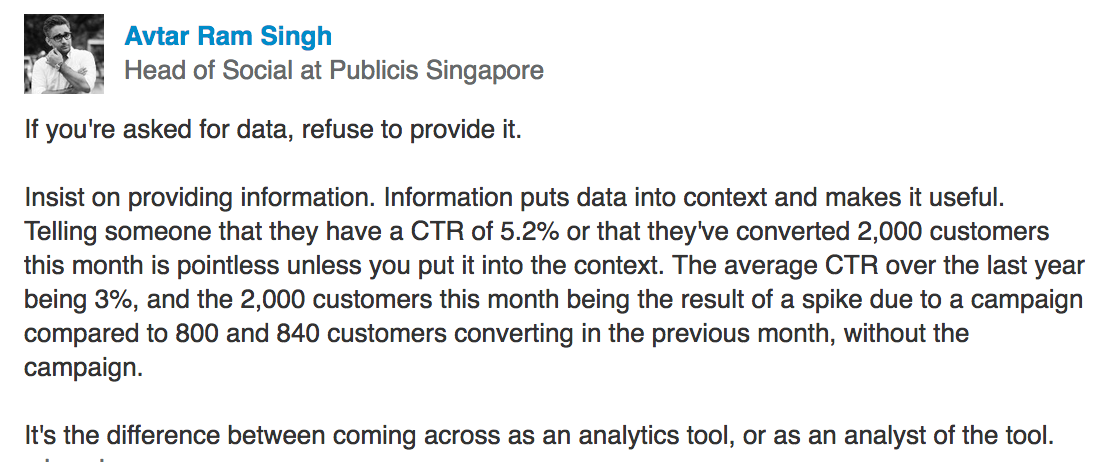“If you’re asked for data, refuse to provide it”—great advice, but not what you think
“If you’re asked for data, refuse to provide it.” Now that’s what I call an attention-getting lede.
At first I thought this LinkedIn post by Avtar Ram Singh, a man I do not know, was about politics. During the recent U.S. presidential transition, the incoming administration asked for lists of federal employees who held views in opposition to their own. You know, about speculative things like climate change. They wanted to know which scientists still believed that their facts trumped (you should pardon the expression) the superior information found elsewhere, like in the Bible. The agencies refused to provide the data to their new overlords. A small victory.
But no, refreshingly, this wasn’t about politics. In the next paragraph, I discovered it was fundamentally about my very favorite subject: Storytelling.

Did I say this was about storytelling? This gobbledygook about CTR (Click Through Ratio, if you’re wondering) and conversions?
Yep. Mr. Singh may not realize it, but when he advises people to put data “into the context,” he’s actually saying, “Use data to tell a story.” Not only does a story make the data more useful, as he notes. It also makes it more memorable. And, as I’ve said before and will surely say again, if you don’t want people to remember what you’re telling them, then why bother?
Telling a story with data
Facts don’t stick in people’s minds. But stories do. So turn your 2,000 conversions into a story:
Our Click Through Ratio nearly doubled last month, and our conversion rate more than doubled.
If you need people to have the hard data, hand it to them separately, or put it in a chart next to the narrative. Do not—please, for the love of all that’s good do NOT—do this:
Our Click Through Ratio nearly doubled last month (from 3% to 5.2%), and our conversion rate more than doubled (840 to 2000).
The data points break up the flow of the sentence and make it harder to understand the point. If you must drop in the numbers, try:
Our Click Through Ratio nearly doubled last month, going from 3% last month to 5.2%. Even better, our conversion rate also skyrocketed: 2000 of those clicks converted into paying customers, up from 840 last month.
Or turn the percentage into people:
We’ve been seeing an average of 3 click-throughs for every 100 people who visit our page. But this month, that number rose to 5.2 click-throughs per 100.
Or—since conversions increased by a much higher percentage than CTR, I wonder if the page didn’t have more traffic coming to it. So you might add some further context:
Over XXX,XXX people visited our page last month and 2000 clicked-through to become paying customers. Our CTR of 5.2% is the highest we’ve seen in a while. nearly double last month’s 3%.
Mr. Singh is absolutely right: “If you’re asked for data, refuse to provide it.” Tell a story instead.